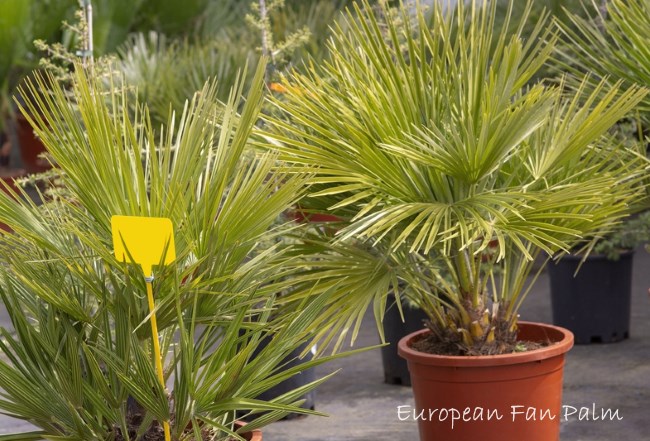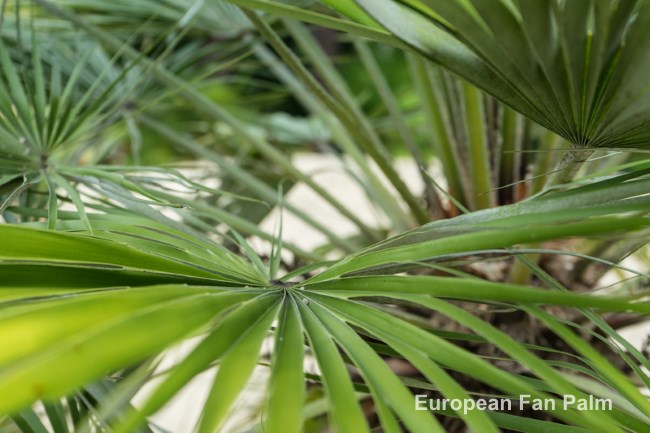European Fan Palm Tree
Botanical Name: Chamaerops humilis
European Fan Palm (aka Mediterranean Fan Palm) is the only palm native to Europe, and is hardier than most palms. Give it the warm, sunny days and cool nights of its native dry mountain habitat and you'll find that it's easy to grow.
 European Fan Palms make handsome, easy-to-please floor plants. Photo © Artesiawells
European Fan Palms make handsome, easy-to-please floor plants. Photo © ArtesiawellsWhat to Know About European Fan Palm
This shrubby palm will eventually reach about 4 ft (1.2 m) tall indoors. As the plant matures, it will grow into multiple rough, thick trunks.
All new growth will come from the palm's crown -- this is where you'll see new fronds. Handle this palm carefully; sharp spines line each stem.
Fine-textured fronds grow in a rounded fan of 10-20 leaflets that reach up to 24 in (60 cm) wide. The leaflets range in color from silvery green to blue-green and naturally split as they mature.
Although slow-growing, it is well worth the wait because even small plants will stand out, making it a stunning sculptural accent for the home. European Fan Palm tree is also long-lived, so you'll enjoy it for many years.
This European palm looks similar to some other fan palms that aren't as easy to please indoors. Look for the Chamaerops humilis botanical name to be sure you're getting this palm.
When and How to Re-Pot
Repot only when needed, about every 3 years or so. European fan palm has fragile roots, so try not to disturb them while repotting. Keep the base of the palm at the same level it was before; don't bury it because the trunk is prone to rotting if it is kept wet.
Wondering what type of pot to use? Roots grow deep and need a deep pot. A heavy pot will prevent toppling because this palm will eventually become top-heavy. Use one with drainage holes so that this palm can be watered thoroughly without worry about root rot.
Once the plant reaches the size you want, you can top-dress it instead by replacing the top couple inches of potting mix. Take care not to disturb any roots that may be near the surface.
European Fan Palm Problems, Solutions and Special Helps
Brown leaf tips may be a symptom of dry soil, dry air or an accumulation of fluoride or chlorine from tap water.
Watering tip: Palms are sensitive to chlorine, fluoride, and other chemicals often found in tap water, as well as the salt in softened water. Use only distilled or filtered water to avoid the build-up of chemicals.
Prune off old, brown fronds. Outer fronds will wither and turn brown. Use clean, sharp pruning shears to cut them off near the trunk of the plant.
Yellow streaks on leaflets is caused by a shortage of magnesium or potassium. Use a fertilizer specially made for palms that include micronutrients. You can quickly revive your houseplant with a spray of micronutrient fertilizer. Adding a pinch of Epsom salts to the water will give it a boost of magnesium.
Something bugging your palm? Peaty potting mixes that are kept moist may attract fungus gnats. Getting rid of them may be as simple as allowing the surface of the soil to dry out. If they persist, check out these ways to get rid of fungus gnats.
Keep fronds dust-free. Take your palm tree outside to a shaded area at least once a year and give it a shower with warm water to rinse off the accumulation of dust. Plant too big to budge? Use a soft, damp cloth to gently wipe off the fronds. Remember, those spines along the stems are sharp! It's a good idea to use thick gloves (like those made for pruning rose bushes) while handling European Fan Palm.
Winter care. Reduce watering during winter when growth slows down because of lower light levels. Also stop fertilizing until spring. Dry indoor air is common in winter, and may attract spider mites. You'll first notice fine webbing between stems and palm fronds. Treat any infestation right away.
 Whorls of fronds add beautiful texture to any sun-splashed room. Photo © Lalalulustock
Whorls of fronds add beautiful texture to any sun-splashed room. Photo © LalalulustockEuropean Fan Palm Care
Origin: Mediterranean region of Southwestern Europe (Spain, Portugal, France, Italy and Malta)
Height: 4 ft (1.2 m) tall
Light: Needs at least 4 hours of direct sun a day, and plenty of bright, indirect light the rest of the day. Give the pot a quarter-turn every week to expose each side to sunlight. Don't have a sunny spot for your European Fan Palm? Using an indoor grow light works beautifully.
Water: Keep constantly moist in spring and summer. In fall and winter, allow top 2 in (5 cm) of soil to dry out between waterings. When grown, Chamaerops humilis is drought-tolerant. If in doubt about whether to water, it's better to err on the side of too dry than too wet. When watering, avoid getting the base of the palm wet to prevent rot. Use a container with drainage holes, and fast-draining potting mix to prevent soggy soil, which may lead to root rot.
Humidity: Average room humidity (around 40% relative humidity). If air is dry in winter, use a cool-mist room humidifier like this one.
Temperature: 70-80°F/21-27°C days; 50-60°F/10-16°C nights
Soil: Mix 2 parts peat moss-based potting mix and 1 part sharp sand. Repot only when necessary, about every 3 years.
Fertilizer: Feed monthly in spring and summer with a fertilizer specially made for palms that contains micronutrients. Do not feed in fall and winter.
Propagation: Sow seeds in spring, barely covering the seeds with soil. Keep them warm (75-80°F/24-27°C) and moist. Palm seeds can take several weeks to germinate, so be patient. European palm is one of the few palms that readily produces suckers that can be cut away and potted in their own containers.


